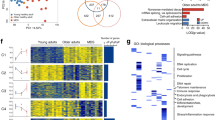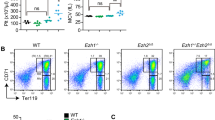Abstract
Friend leukemia virus integration 1 (Fli1) and erythroid Krüppel-like factor (EKLF) participate under experimental conditions in the differentiation of megakaryocytic and erythroid progenitor in cooperation with other transcription factors, cytokines, cytokine receptors, and microRNAs. Defective erythropoiesis with refractory anemia and effective megakaryopoiesis with normal or increased platelet count is typical for 5q- syndrome. We decided to evaluate the roles of EKLF and Fli1 in the pathogenesis of this syndrome and of another ribosomopathy, Diamond–Blackfan anemia (DBA). Fli1 and EKLF mRNA levels were examined in mononuclear blood and bone marrow cells from patients with 5q- syndrome, low-risk MDS patients with normal chromosome 5, DBA patients, and healthy controls. In 5q- syndrome, high Fli1 mRNA levels in the blood and bone marrow mononuclear cells were found. In DBA, Fli1 expression did not differ from the controls. EKLF mRNA level was significantly decreased in the blood and bone marrow of 5q- syndrome and in all DBA patients. We propose that the elevated Fli1 in 5q- syndrome protects megakaryocytic cells from ribosomal stress contrary to erythroid cells and contributes to effective though dysplastic megakaryopoiesis.



Similar content being viewed by others
References
Debili N, Coulombel L, Croisille L, Katz A, Gouichard J, Breton-Gorius J et al (1996) Characterization of a biponent erythro-megakaryocytic progenitor in human bone marrow. Blood 88:1284–1296
Klimchenko O, Mori M, Distefano A, Langlois T, Larbret F, Lecluse Y et al (2009) A common bipotent progenitor generates the erythroid and megakaryocyte lineages in embryonic stem cell-derived primitive hematopoiesis. Blood 114:1506–1517
Frontelo P, Manwani D, Galdass M, Karsunky H, Lohmann F, Gallagher PG et al (2007) Novel role for EKLF in megakaryocyte lineage commitment. Blood 110:3871–3880
Bouilloux F, Juban G, Cohet N, Buet D, Guyot B, Vainchenker W et al (2008) EKLF restricts megakaryocytic differentiation at the benefit of erythrocytic differentiation. Blood 112:576–584
Starck J, Cohet N, Gonnet C, Sarrazin S, Doubeikovskaja Z, Doubeikovskij A et al (2003) Functional cross-antagonism between transcription factors FLI-1 and EKLF. Mol Cell Biol 23:1390–1402
Siatecka M, Bieker JJ (2011) The multifunctional role of EKLF/KLF1 during erythropoiesis. Blood 18:2044–2054
Doré LC, Crispino JD (2011) Transcription factor in erythroid cell and megakaryocyte development. Blood 118:231–239
Luo Q, Ma X, Wahl SM, Bieker JJ, Crossley M, Montaner LJ (2004) Activation and repression of interleukin-12 p40 transcription by erythroid Krüppel-like factor in macrophages. J Biol Chem 279:18451–18456
Donze D, Townes TM, Bieker JJ (1995) Role of erythroid Krűppel-like factor in human gamma- to beta-globin gene switching. J Biol Chem 270:1955–1959
Tallack MR, Whitington T, Yuen WS, Wainwright EN, Keys JR, Gardiner BB et al (2010) A global role for KLF1 in erythropoiesis revealed by ChIP-seq in primary erythroid cells. Genome Res 20:1052–1063
Siatecka M, Sahr KE, Andersen SG, Mezel M, Bieker JJ, Peters LL (2010) Severe anemia in the Nan mutant mouse caused by sequence-selective disruption of erythroid Krüppel-like factor. Proc Natl Acad Sci U S A 107:15151–15156
Borg J, Papadopoulos P, Georgitsi M, Gutiérrez L, Grech G, Fanis P et al (2010) Haploinsufficiency for the erythroid transcription factor KLF1 causes hereditary persistence of fetal hemoglobin. Nat Genet 42:801–805
Satta S, Perseu L, Moi P, Asunis I, Cabriolu A, Maccioni L et al (2011) Compound heterozygosity for KLF1 mutations associated with remarkable increase of fetal hemoglobin and red cell protoporphyrin. Haematologica 96:767–770
Gallienne AE, Dréau HMP, Schuh A, Old JM, Henderson S (2012) Ten novel mutations in the erythroid transcription factor KLF1 gene associated with increased fetal hemoglobin levels in adults. Haematologica 97:340–343
Arnaud L, Saison C, Helias V, Lucien N, Steschenko D, Giarratana MC et al (2010) A dominant mutation in the gene encoding the erythroid transcription factor KLF1 causes a congenital dyserythropoietic anemia. Am J Hum Genet 87:721–727
Mélet F, Motro B, Rossi DJ, Zhang L, Bernstein A (1996) Generation of a novel Fli-1 protein by gene targeting leads to a defect in thymus development and a delay in Friend virus-induced erythroleukemia. Mol Cell Biol 16:2708–2718
Eisbacher M, Holmes ML, Newton A, Hogg PJ, Khachigian LM, Crossley M et al (2003) Protein-protein interaction between Fli-1 and GATA-1 mediates synergistic expression of megakaryocyte-specific genes through cooperative DNA binding. Mol Cell Biol 23:3427–3441
Fuhrken PG, Chen C, Apostolidis PA, Wang M, Miller WM, Papoutsakis ET (2008) Gene ontology-driven transcriptional analysis of CD34+ cell-initiated megakaryocytic cultures identifies new transcriptional regulators of megakaryopoiesis. Physiol Genomics 33:159–169
Starck J, Weiss-Gayet M, Gonnet C, Guyot B, Vicat JM, Morlé F (2010) Inducible Fli-1 gene deletion in adult mice modifies several myeloid lineage commitment decisions and accelerates proliferation arrest and terminal erythrocytic differentiation. Blood 116:4795–4805
Kawada H, Ito T, Pharr PN, Spyropoulos DD, Watson DK, Ogawa M (2001) Defective megakaryopoiesis and abnormal erythroid development in Fli-1 gene-targeted mice. Int J Hematol 73:463–468
Moussa O, LaRue AC, Abangan RS Jr, Williams CR, Zhang XK, Masuya M et al (2010) Thrombocytopenia in mice lacking the carboxy-terminal regulatory domain of the Ets transcription factor Fli1. Mol Cell Biol 30:5194–5206
Huang H, Yu M, Akie TE, Moran TB, Woo AJ, Tu N et al (2009) Differentiation-dependent interactions between RUNX-1 and FLI-1 during megakaryocyte development. Mol Cell Biol 29:4103–4115
Svenson JL, Chike-Harris K, Amria MY, Nowling TK (2010) The mouse and human FLi1 genes are similarly regulated by Ets factors in T cells. Genes Immun 11:161–172
Hodge DR, Li D, Qi SM, Farrar WL (2002) IL-6 induces expression of the Fli-1 proto-oncogene via STAT3. Biochem Biophys Res Commun 292:287–291
Starck J, Doubeikovski A, Sarrazin S, Gonnet C, Rao G, Skoultchi A et al (1999) Spi-1/PU.1 is a positive regulator of the FLi-1 gene involved in inhibition of erythroid differentiation Friend erythroleukemic cell lines. Mol Cell Biol 19:121–135
Truong AH, Cervi D, Lee J, Ben-David Y (2005) Direct transcriptional regulation of MDM2 by Fli-1. Oncogene 24:962–969
Kumar MS, Narla A, Nonami A, Mullally A, Dimitrova N, Ball B et al (2011) Coordinate loss of a microRNA and protein-coding gene cooperate in the pathogenesis of 5q- syndrome. Blood 118:4666–4673
Zhang J, Guo H, Zhang H, Wang H, Qian G, Fan X et al (2011) Putative tumor suppressor miR-145 inhibits colon cancer cell growth by targeting oncogene Friend leukemia virus integration 1 gene. Cancer 117:86–95
Boultwood J, Pellagatti A, Cattan H, Lawrie CH, Giagounidis A, Malcovati L et al (2007) Gene expression profiling of CD34+ cells in patients with the 5q- syndrome. Br J Haematol 139:578–589
Raslova H, Komura E, Le Couédic JP, Larbred F, Debili N, Feunteun J et al (2004) FLi1 monoallelic expression combined with its hemizygous loss underlines Paris-Trousseau/Jacobsen thrombopenia. J Clin Invest 114:77–84
Neuwirtova R, Fuchs O, Provaznikova D, Cermak J, Siskova M, Jonasova A et al (2009) Fli-1 and EKLF gene expression in patients with MDS 5q- syndrome. Blood 114:1090–1091, Abstract 2788
Neuwirtova R, Fuchs O, Pospisilova D, Cmejla R, Holicka M, Vostry M, Kostecka A, Hajkova H, Jonasova A, Cermak J, Michalova K, Brezinova J (2011) The significance of megakaryocytic transcription factor Fli1 and erythroid transcription factor EKLF in the ribosomopathies: 5q minus syndrome and Diamond–Blackfan anemia, the role of Fli1 in p53 regulation and in 5q minus syndrome megakaryopoiesis. Blood 118:1634, Abstract 3825
Ellis SR, Gleizes PE (2011) Diamond–Blackfan anemia: ribosomal proteins going rogue. Semin Hematol 48:89–96
Narla A, Hurst SN, Ebert BL (2011) Ribosome defects in disorders of erythropoiesis. Int J Hematol 93:144–149
van den Berghe H, Cassiman JJ, David G, Fryns JP, Michaux JL, Sokal G (1974) Distinct haematological disorder with deletion of long arm of no. 5 chromosome. Nature 251:437–438
Cmejla R, Cmejlova J, Handrkova H, Petrak J, Pospisilova D (2007) Ribosomal protein S17 gene (RPS17) is mutated in Diamond–Blackfan anemia. Hum Mutat 28:1178–1182
Cmejla R, Blafkova J, Stopka T, Jelinek J, Petrtylova K, Pospisilova D (2000) Ribosomal protein S19 gene mutations in patients with Diamond–Blackfan anemia and identification of ribosomal protein S19 pseudogenes. Blood Cells Mol Dis 26:124–132
Cmejla R, Ludikova B, Sukova M, Blatny J, Pospisilova D (2011) Can mutations in the ribosomal protein S26 (RPS26) gene lead to Klippel–Feil syndrome in Diamond–Blackfan anemia patients? An update from the Czech Diamond–Blackfan Anemia Registry. Blood Cells Mol Dis 46:300–301
Cmejla R, Cmejlova J, Handrkova H, Petrak J, Petrtylova K, Mihal V et al (2009) Identification of mutations in the ribosomal protein L5 (RPL5) and ribosomal protein L11 (RPL11) genes in Czech patients with Diamond–Blackfan anemia. Hum Mutat 30:321–327
Bock C, Reither S, Mikeska T, Paulsen M, Waiter J, Lenqauer T (2005) BiQ analyzer: visualization and quality control for DNA methylation data from bisulfite sequencing. Bioinformatics 21:4067–4068
Boultwood J, Fidler C, Strickson AJ, Watkins F, Gama S, Kearney L et al (2002) Narrowing and genomic annotation of the commonly deleted region of the 5q- syndrome. Blood 99:4638–4641
Ebert BL (2011) Molecular dissection of the 5q deletion in myelodysplastic syndrome. Semin Oncol 38:621–626
Starczynowski DT, Kuchenbauer F, Argiropoulos B, Sung S, Morin R, Muranyi A et al (2010) Identification of miR-145 and miR-146a as mediators of the 5q- syndrome. Nat Med 16:49–58
Navarro S, Debili N, Le Couedic JP, Klein B, Breton-Gorius J, Doly J et al (1991) Interleukin-6 and its receptor are expressed by human megakaryocytes: in vitro effects on proliferation and endoreplication. Blood 77:461–471
Ebert BL, Pretz J, Bosco J, Chang CY, Tamayo P, Galili N et al (2008) Identification of RPS14 as a 5q- syndrome gene by interference screen. Nature 451:335–339
Zhang Y, Lu H (2009) Signaling to p53: ribosomal proteins find their way. Cancer Cell 16:369–377
Barlow JL, Drynan LF, Hewett DR, Holmes LR, Lorenzo-Abalde S, Lane AL et al (2010) A p53-dependent mechanism underline macrocytic anemia in a mouse model of human 5q- syndrome. Nat Med 16:59–66
Pellagatti A, Marafioti T, Paterson JC, Barlow JL, Drynan LF, Giagunidis A et al (2010) Induction of p53 and up-regulation of the p53 pathway in the human 5q- syndrome. Blood 115:2721–2723
Dutt S, Narla A, Lin K, Mullally A, Abayasekara N, Megerdichian C et al (2011) Haploinsufficiency for ribosomal protein genes causes selective activation of p53 in human erythroid progenitor cells. Blood 117:2567–2576
Galili N, Cruz R, Stratton J, Clima J, Sajjad Khan G, Raza A (2011) A pluralistic approach to the study of myelodysplastic syndromes: evolving pathology of the seed via the soil. In: Saba HI, Mufti GJ (eds) Advances in malignant hematology. Wiley, Oxford, pp 143–152
Hodge DR, Xiao W, Clausen PA, Heidecker G, Szyf M, Farrar WL (2001) Interleukin-6 regulation of the human DNA methyltransferase (HDNMT) gene in human erythroleukemia cells. J Biol Chem 276:39508–39511
McGowan KA, Pang WW, Bhardwaj R, Perez MG, Pluvinage JV, Glade BE et al (2011) Reduced ribosomal protein gene dosage and p53 activation in low risk myelodysplastic syndrome. Blood 118:3622–3633
Acknowledgments
This work was supported by the research grant NT/13836-4/2012 from the Ministry of Health of the Czech Republic and by the research grant PRVOUK-P27/LF1/2.
Authors' contributions
RN and OF designed the experiments. OF, MH, MV, AK, HH, and MB performed the experiments with the assistance of RC. RN, OF, MH, AK, and HH analyzed the data. KM and JB provided cytogenetical data. RN, AJ, JC, DP, RC, MS, IH, JV, DS, EK, and LN provided the patient clinical samples and hematological data. RN and OF, with the input of HH, wrote the paper.
Conflict of interest
The authors declare no conflict of interest.
Author information
Authors and Affiliations
Corresponding author
Electronic supplementary material
Below is the link to the electronic supplementary material.
ESM 1
(DOCX 16 kb)
Rights and permissions
About this article
Cite this article
Neuwirtova, R., Fuchs, O., Holicka, M. et al. Transcription factors Fli1 and EKLF in the differentiation of megakaryocytic and erythroid progenitor in 5q- syndrome and in Diamond–Blackfan anemia. Ann Hematol 92, 11–18 (2013). https://doi.org/10.1007/s00277-012-1568-1
Received:
Accepted:
Published:
Issue Date:
DOI: https://doi.org/10.1007/s00277-012-1568-1




